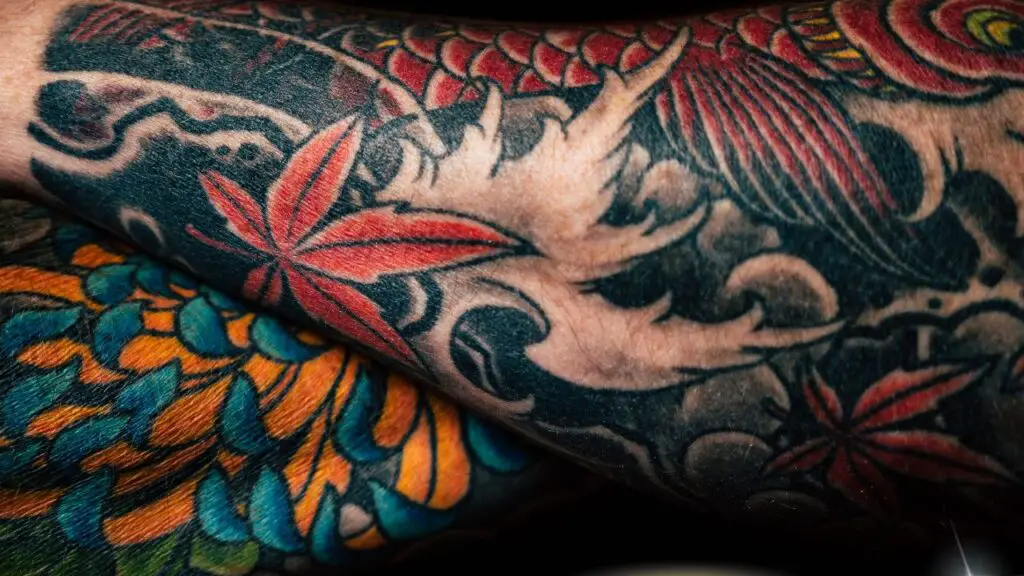What is Red Tattoo | Intriguing World of Red Tattoos | 2023
"Exploring the Enigmatic World of Red Tattoos in Islam"

Are Red Tattoos Allowed in Islam?
The permissibility of red tattoos in Islam is a subject of debate among scholars. Some view them as culturally significant and acceptable, while others argue against any form of tattooing due to concerns about harming the body. Ultimately, it varies based on individual interpretation and cultural context.

- What is Radical Islam? | originated in the late 19th century | Controversial Ideology
- Al Qaeda Definition in islam : Persistent Threat to Global Security
- Muslim Inventions Since 610 A.D to 2023
- 444 Tattoo Meaning in Islam : Mystery Revealed
- Is Sugar Alcohol Haram?
Introduction
Tattoos have been an integral part of human culture for centuries, symbolizing various aspects of identity, culture, and personal beliefs. In the Islamic world, tattoos have a complex and often debated place in religious tradition and practice. One specific type of tattoo that has garnered particular attention is the red tattoo. In this article, we will delve into the significance of red tattoos in Islam, exploring their history, interpretations, and the diverse perspectives within the Muslim community.
The History of Tattoos in Islam
Tattoos in the Islamic world have a long and varied history. The practice of tattooing has been documented in different Muslim-majority regions, each with its own unique cultural and religious influences. While the Quran, the holy book of Islam, does not explicitly forbid tattooing, it does emphasize the importance of respecting one’s body and avoiding unnecessary harm. This ambiguity has allowed for differing interpretations regarding the permissibility of tattoos in Islam.
An Intriguing Subset

Among the various types of tattoos, red tattoos hold a special place in Islamic culture. These tattoos are often created using a mixture of henna, a natural dye derived from the henna plant, and other ingredients to achieve a red or reddish-brown hue. The use of henna for body decoration predates Islam and was a common practice in many Middle Eastern and North African cultures. It was subsequently adopted by Muslims for various occasions.
Significance
- Celebratory and Festive: Red tattoos, often applied on special occasions such as weddings, Eid celebrations, and other joyous events, symbolize happiness, love, and festivity. In many cultures, intricate red henna designs are applied to the hands and feet of brides as a symbol of beauty and good fortune.
- Spiritual and Protective: Some Muslims believe that red tattoos can offer spiritual protection. These tattoos are seen as a form of defense against the evil eye and negative energy. The use of red ink or henna is thought to ward off malevolent forces and bring blessings to the wearer.
- Temporary and Symbolic: Red tattoos are typically temporary, fading over time as the skin naturally sheds. This temporariness aligns with the Islamic perspective on tattoos, where permanent alterations to the body may be discouraged. Red tattoos allow individuals to express themselves artistically and symbolically without making permanent changes to their bodies.

Are red tattoo allowed in Islam?
The permissibility of it Islam is a subject of debate among scholars. Some view them as culturally significant and acceptable, while others argue against any form of tattooing due to concerns about harming the body. Ultimately, it varies based on individual interpretation and cultural context.
What is the significance of red tattoos in Islamic culture?
Red tattoos, often made with henna, hold cultural and symbolic significance in Islamic culture. They are used to celebrate joyous occasions like weddings and Eid, symbolizing happiness, love, and protection against the evil eye.
Are red tattoos permanent?
They are created with henna are not permanent. They gradually fade over time as the outer layer of skin sheds, making them a temporary form of body decoration.
Are there any verses in the Quran that explicitly mention tattoos?
No, the Quran does not explicitly mention tattoos. Islamic perspectives on tattoos are largely based on interpretations of broader principles, such as respecting one’s body and avoiding harm.
Can red tattoos protect against the evil eye?
Some people believe that they can offer protection against the evil eye and negative energy. This belief is rooted in cultural and superstitious traditions.
Diverse Perspectives within Islam
While red tattoos have found acceptance and popularity in many Muslim-majority regions, there is no unanimous stance on their permissibility within the broader Islamic community. Interpretations of Islamic teachings can vary significantly among scholars and individuals. Some view red tattoos as a harmless and culturally significant practice, while others consider any form of tattooing as contrary to Islamic values.
- Cultural Variations: The acceptance of red tattoos often depends on the cultural and regional context. In some places, red tattoos are deeply ingrained in local traditions and are seen as an expression of cultural identity rather than a religious statement.
- Scholarly Debates: Islamic scholars have debated the permissibility of tattoos, with opinions ranging from strict prohibition to conditional acceptance. Scholars who oppose tattoos argue that they may harm the body, while others who support them cite the absence of explicit Quranic prohibitions.
- Personal Beliefs: Many Muslims make their own decisions regarding tattoos based on their personal interpretation of Islamic principles. Some may choose to embrace red tattoos for their cultural and symbolic significance, while others may avoid them due to concerns about religious purity.
Conclusion
In Islam, Tattoos serve as a fascinating intersection of culture, tradition, and religion. While they are often associated with joyous occasions and protective symbolism, their permissibility remains a subject of debate within the Muslim community. As with many aspects of Islamic practice, individual beliefs and interpretations play a significant role in shaping one’s perspective on red tattoos. Ultimately, the diverse and multifaceted nature of Islam allows for a range of opinions and practices regarding this unique form of body art.

Faqs
Do all Muslims accept red tattoos?
No, acceptance of it varies among Muslims. It depends on individual beliefs, cultural background, and religious interpretation. Some Muslims embrace them as part of their culture, while others avoid them due to concerns about religious purity.
How long do red tattoos made with henna typically last?
They are made with henna are temporary and can last anywhere from a few days to a few weeks, depending on factors like skin type, aftercare, and the quality of the henna used.
Are red tattoos exclusive to a particular region within the Islamic world?
Red tattoos, especially those made with henna, are prevalent in various Muslim-majority regions, including the Middle East, North Africa, South Asia, and parts of Southeast Asia. Their popularity varies from place to place.
Can non-Muslims get red tattoos?
Red tattoos made with henna are not exclusive to Muslims, and non-Muslims can get them if they wish. These tattoos are often appreciated for their aesthetic and cultural significance beyond religious boundaries.
Is it disrespectful for non-Muslims to get red tattoos?
While red tattoos have cultural and religious significance for some Muslims, it is generally not considered disrespectful for non-Muslims to get them. However, it’s essential to be respectful and informed about the cultural and religious aspects of the tattoo when getting one.





